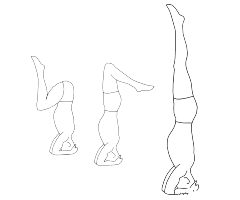SHIRSHASANA or HAND STAND OR शीर्ष आसन
We are all familiar with the notion that yoga comprises distinct poses. These poses are built in such a way that it accentuates your performance and promotes good health. One of the endearing yoga poses is Shirshasana. In English, it is synonymous with headstand but both have certain dissimilarities. Today, we shall discuss this amazing exercise and its benefits.
1. WHAT IS SHIRSHASANA?
As the name suggests, Shirshasana is a pose that involves standing with your head. You should not take its meaning in the literal sense as you’ll use your forearms for support. In ancient yoga scriptures, this pose is regarded as the king of all yoga poses. It is hard to argue with that fact as this pose provides immense mental, physical, and psychological benefits.
In short, the Shirshasana pose impacts every aspect of your body and makes the practitioner capable of understanding and practicing other yoga poses.
2. BENEFITS OF SHIRSHANA POSE
Before we teach you how to part of this pose, let’s take a look at its benefits. Keep in mind that this pose is difficult to muster but once you acquaint yourself, the benefits are unparalleled. Some of them are given below:
- As the body is inverted in this pose, it balances the circulatory system. The respiratory system and circulatory system become strong.
- Conditions revolving around the eyes, nose, ears, and throat may become better.
- A great remedy for constipation.
- Enhanced mental and intellectual prowess.
- The nervous system gets much-needed nutrition from this pose.
- Enhanced willpower and concentration.
- Decreases the fluid retention in the legs.
- Invigorates the arms, back pain, and shoulder muscles.
- Reduced depression, fatigue, and fears.
- Improves digestion
- Stimulates the lymphatic system of the body.
These were the amazing benefits of the Shirshasana pose. Now, let’s take a look at some of the precautions that you need to understand while practicing this pose.
3. PRECAUTIONS
You should refrain from practicing this pose if you have certain ailments. Some of them are:
- Headaches that occur frequently
- High blood pressure and neck issues
- Comparatively weaker blood vessels in the eye
- Kidney problems
- Joint and back problems
- Migraine
- Glaucoma
- Conjunctivitis
- Thrombosis
If you feel that you suffer from the above-mentioned conditions, then we suggest that you visit a doctor. Only when the doctor gives you the green signal, you can practice this pose.
4. HOW TO DO THIS POSE
In this blog, we shall provide you a thorough guide about how to perform the Shirshasana pose.
- Sit gently on your knees and hold the elbows to check the actual distance. Slowly, place your arms on the floor, right below your shoulders.
- Placing the elbows there, bring the hands closer and lock your fingers to form a cup.
- Slowly straighten your knees while keeping the elbows and head in the same position.
- Lift the hips upward and make sure that you keep your weight in the elbows. Continue walking until your hips sit above your shoulders.
- You can lift either one foot at a time or you can lift both of them simultaneously. You can hold this position for one breath and push the elbows on the floor while doing so.
- Relax for a minute and continue the entire process 3-4 times.
5. TIPS FOR THIS POSE
As you have learned how to do Shirshasana, here are some tips that will make practicing it easier.
- Practice the mountain pose for better performance.
- Place a small folded blanket below your forearms if you have discomfort in the head.
- While practicing it for the first time, make sure that you don’t put all the pressure on the head.
- Use your hands as balancing objects.
- Practice this pose consistently to see maximum benefits.
- If you are new to yoga, then practice this pose at the end.
Thus, these were the basic know-hows relating to Shirshasana. We hope that you will implement these techniques and perfect your yoga.
